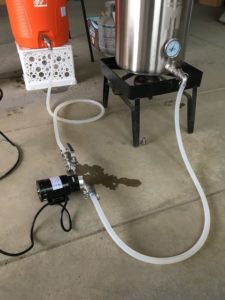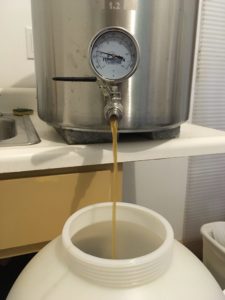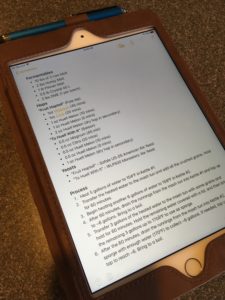The idea to brew a pale ale next, was inspired by a beer we had in Portsmouth, New Hampshire at the excellent Earth Eagle Brewings. Their popular Shepard’s Crook pale ale uses the Huell Melon hop, with which we were unfamiliar. The hop has some honeydew melon and strawberry aromas that were quite enjoyable. I believe lead brewer, Josh Smith, told us that the other hops were from New Zealand. The recipe(s) below are not in any way an attempt to recreate their beer, but an attempt to re-create some of the aromas from the beer that were appealing and I thought might lend themselves to the two beers in the recipe(s).
In a nutshell, parti-gyle brewing is an old technique for when you want to make two or more beers from one mash. Historically, old brewing methods would brew multiple beers from a single grain bill. The first runnings would be quite strong, and have much needed calories. The second runnings would be weaker, but still pack a punch; and any subsequent runnings would be quite low in alcohol, and could be consumed daily being a “small” beer. The small beers would even be consumed by children because it was safer than drinking water. The boiling process would kill anything in the water.
For me parti-gyle brewing helps me achieve my goal of efficiency. A brew day is a brew day and like most people, my days seem to fill up with Things That Need To Be Done. Brewing more than one beer doesn’t take twice as long using this method, so why not make more beer?
Here’s my take on getting more beer out of your brew day which also allows you to be crafty and creative. Play around, and drink the results.™

The caveats to the parti-gyle process are that it helps to have multiple heating sources, and an extra kettle. I have the luxury of being able to borrow the gas burner Sarah uses for dyeing fiber. Also, if you are concerned about hitting OG or ABV targets you will need to do some maths or use an online calculator designed for these sorts of things. I’m not concerned with these targets, and am only trying to get the right hop-to-malt balance in the final beers. I don’t want to have a beer that is too malty with not enough bite, nor one that is too hoppy for a thinner-bodied beer. So, in my original recipe below, I decided to add fewer hops in the kettle for the second beer, and I added some DME to both batches to boost the body and the alcohol.
While the brews below are very similar by design, this method allows for some creativity as well. In this case, the first beer is a pale ale, and the second is a Belgian pale ale; however, it could just as easily be a brown ale with the addition of more dark specialty grains steeped in the second runnings, and different hops and yeast.
The first beer, which we are calling “Fruit Hoptail” uses an American ale yeast known for well-balanced beers with low diacetyl and a very crisp end palate. That should allow for the hops to feature. The second runnings, “To Huell With It,” has a yeast from a Belgian monastery, and produces distinctive fruitiness and plum characteristics. I hope it will be okay as the yeast is often used in higher gravity beers. The selection of this yeast is the biggest risk I am taking in the recipe, as far as I am concerned.
Fruit Hoptail & To Huell With It

Fermentables
- 10 lbs of 2-row Malt (Canada)
- 2 lbs Gambrinus Honey Malt (Canada)
- 1 lb Briess Pilsner Malt (US)
- 0.5 lb Crystal 40 L
- 2 lbs Briess Pale Ale DME (1 per batch)
Hops
“Fruit Hoptail” (Pale Ale)
- 1.5oz Magnum (11.8%) – 45 mins
- 1.5oz Citra (12.2%) – 20 mins
- 1 oz Huell Melon (4.5%) – 10 mins
- 1 oz Huell Melon – 0 mins
- 2 oz Huell Melon – dry hop in secondary
“To Huell With It” (Belgian Pale Ale)
- 0.5 oz Magnum – 45 min
- 0.5 oz Citra – 20 mins
- 0.5 oz Huell Melon – 10 mins
- 0.5 oz Huell Melon – 0 mins
- 1 oz Huell Melon – dry hop in secondary
Yeasts
- “Fruit Hoptail” – Safale US-05 American Ale Yeast
- “To Huell With It” – WLP500 Monastery Ale Yeast

Process
- Heat 5 gallons of water to 154ºF in Kettle #1.
- Transfer the heated water to the mash tun and add all the crushed grains. Hold for 60 minutes.
- Begin heating another 6 gallons of water to 158ºF in Kettle #2.
- After 60 minutes, drain the runnings from the mash tun into Kettle #1 and top up to ~5.5 gallons. Bring to a boil.
- Transfer 3 gallons — or enough to at least cover the grains completely — of the heated water to the mash tun (with the same grains) and hold for 60 minutes. Hold the remaining water covered with a lid, and then bring the remaining water up to 170ºF to use as sparge.
- After the 60 minutes, drain the runnings from the mash tun into Kettle #2, and sparge with enough water (170ºF) to collect ~5.5 gallons. If needed, top up with tap to get there. Bring to a boil.
Kettle #1 – “Fruit Hoptail” (60 minute boil)
- Add 1.5oz Magnum hops at 45 minutes
- Add 1.5oz Citra hops at 20 mins
- Add 1 lb of DME at 15 mins
- Add 1oz Huell Melon hops at 10 mins
- Add 1oz Huell Melon hops at flame out
- Chill to ~70 degrees and pitch yeast (US-05). Seal and connect airlock.
- After primary fermentation has completed (~1 week), transfer to secondary fermentation vessel* and add 2oz Huell Melon as dry hop.
- Wait two weeks, and transfer to bottling bucket or keg. (This is likely to be kegged.)
- If bottling, give at least 3 weeks to condition. Then enjoy!
OG: 1050
FG: TBD
Kettle #2 – “To Huell With It” (60 minute boil)
- Add 0.5oz Magnum hops at 45 minutes
- Add 0.5oz Citra hops at 20 mins
- Add 1 lb of DME at 15 mins
- Add 0.5oz Huell Melon hops at 10 mins
- Add 0.5oz Huell Melon hops at flame out
- Chill to ~70 degrees and pitch yeast (WLP500)
- After primary fermentation has completed (~1 week), transfer to secondary fermentation vessel and add 2 oz Huell Melon hops to dry hop.
- Wait two weeks, and transfer to bottling bucket or keg. (This is likely to be bottled.)
OG: TBD
FG: TBD
* We used the FastFerment for the “Fruit Hoptail,” which doesn’t require racking. The Belgian will be racked from the fermenting bucket to a glass carboy and dry hopped.

I can’t say enough how much easier my brew day went because I mapped the process beforehand. In addition, knowing my equipment — especially the burners and pots — helped me time things so the water I needed was at the right temperature when I needed it to be. And other steps, including clean up, could be completed between steps. I am please to report that I was able to get both beers in their primary fermentation vessels in 6 hours from flame-on to final pitch. I did have some help with carrying heavy kettles and clean up, and for that I am grateful. That’s still a long day, but I would normally get one beer done in about 4-5 hours.
Keep and eye out for a future video on how these parti-gyle beers turned out! Check back soon for my interview with Sarah where I discuss this beer, and if you try this method or the recipes in this post, please let us know how it turned out for you in the comments, or send a private note via the contact us page.

To Huell With It: A Belgian Ale | Vermont Craft Tours
December 25, 2017 at 5:45 pm[…] Parti-gyle: Two Distinct Beers from One Grain Bill (includes detailed recipe) […]
Tasting Fruit Hoptail with Huell Melon hops | Vermont Craft Tours
January 1, 2018 at 4:37 am[…] Parti-gyle: Two Beers from One Grain Bill – Includes a detailed recipe for the beer we’re tasting in the video. […]